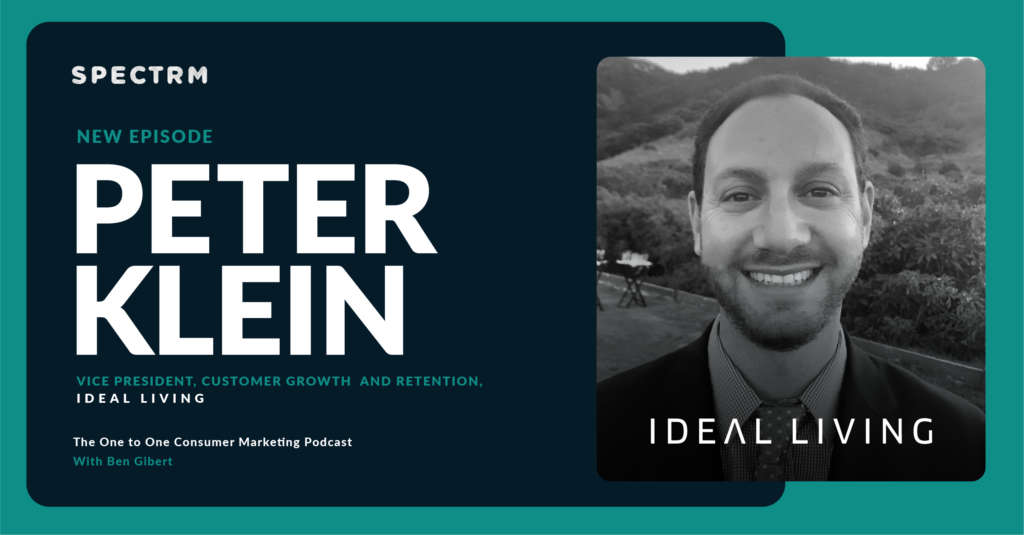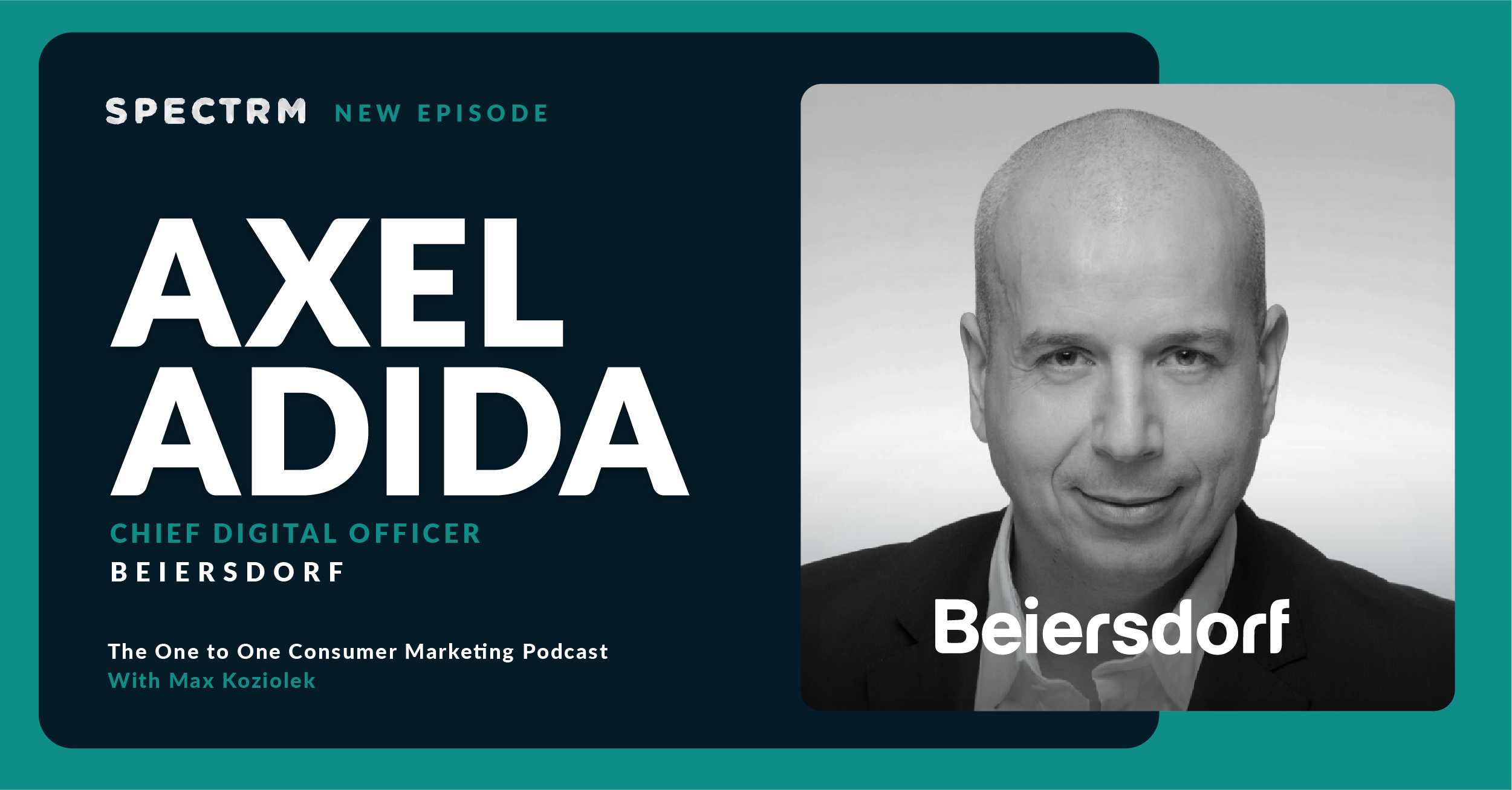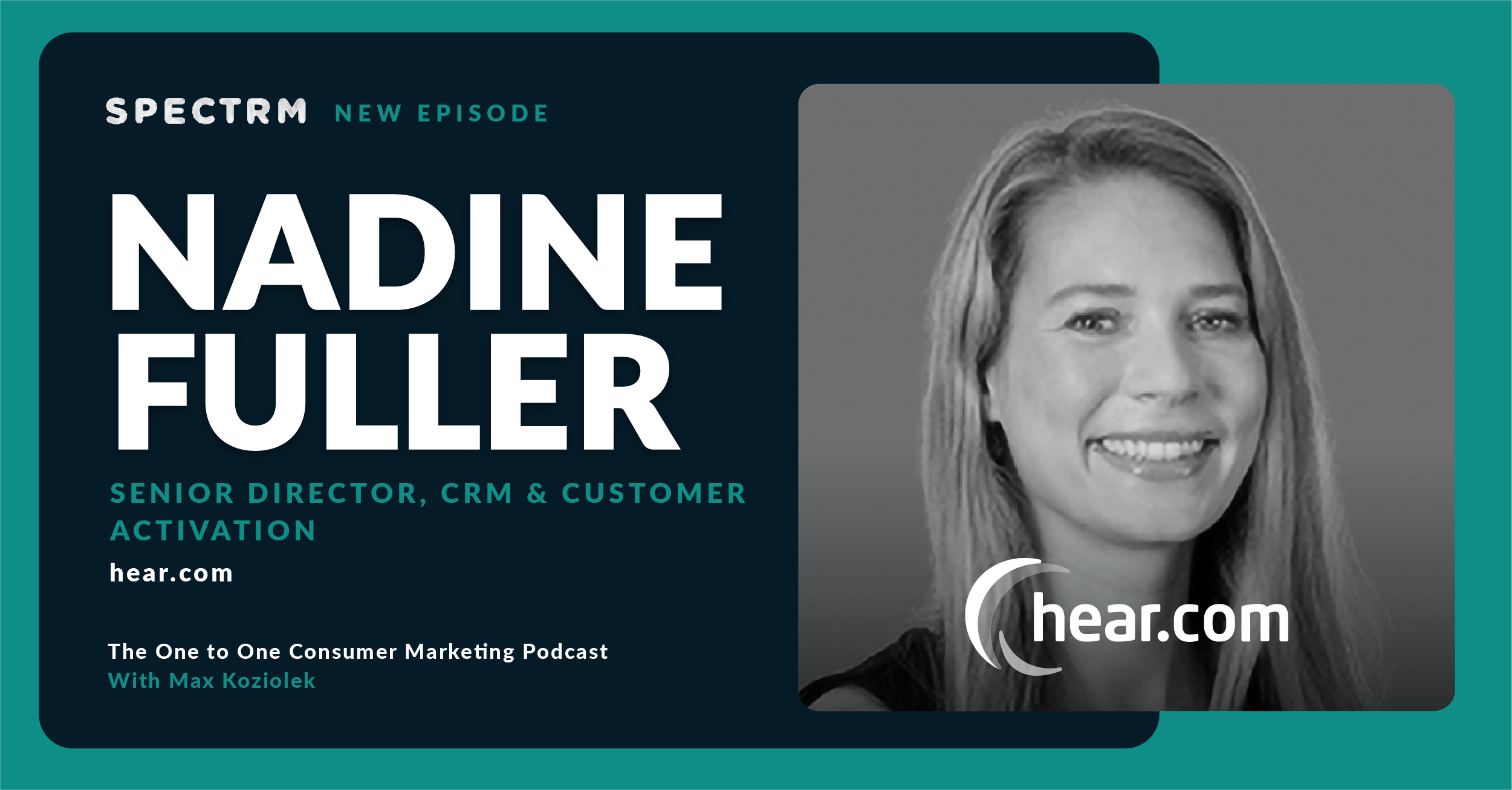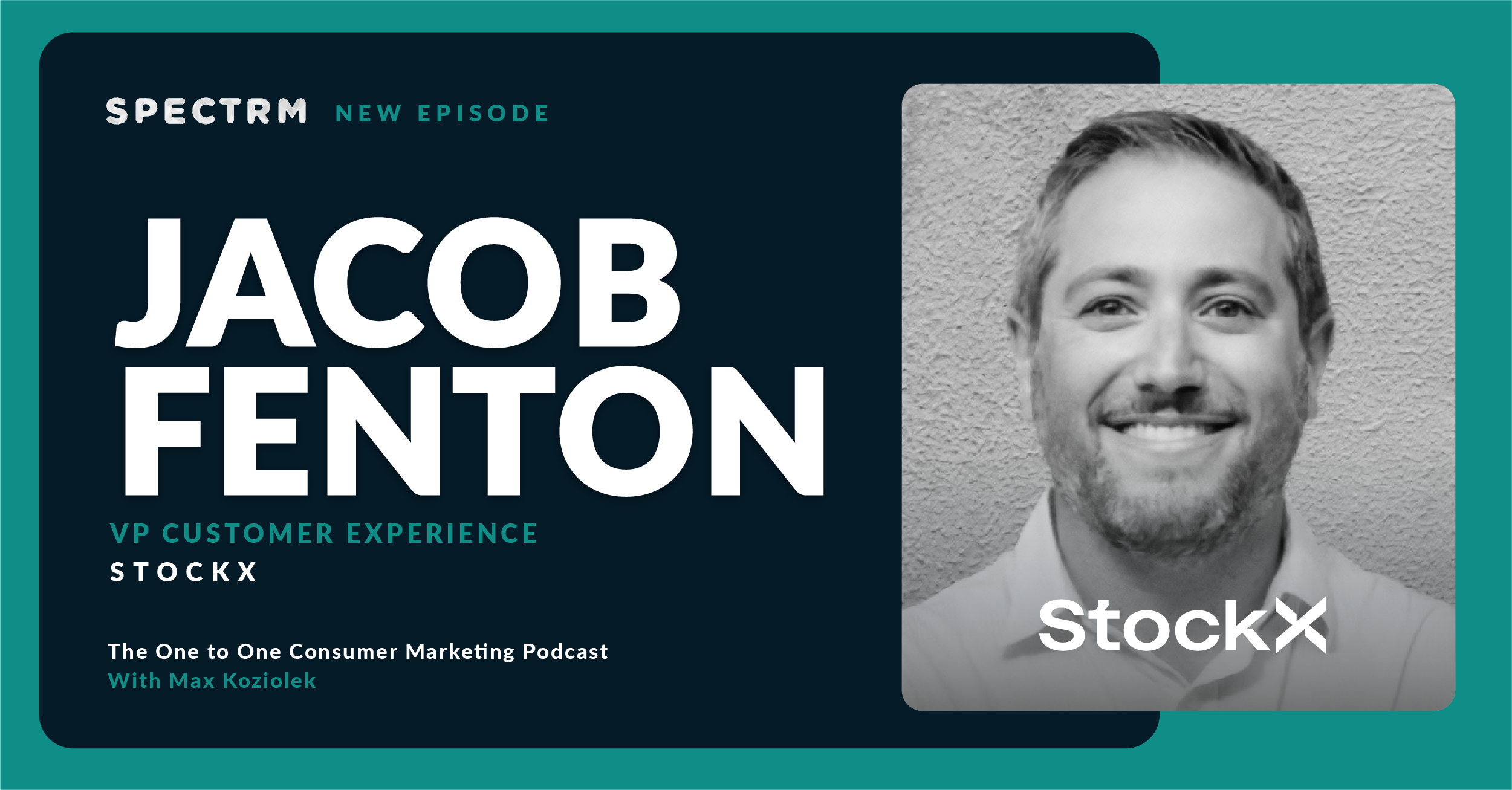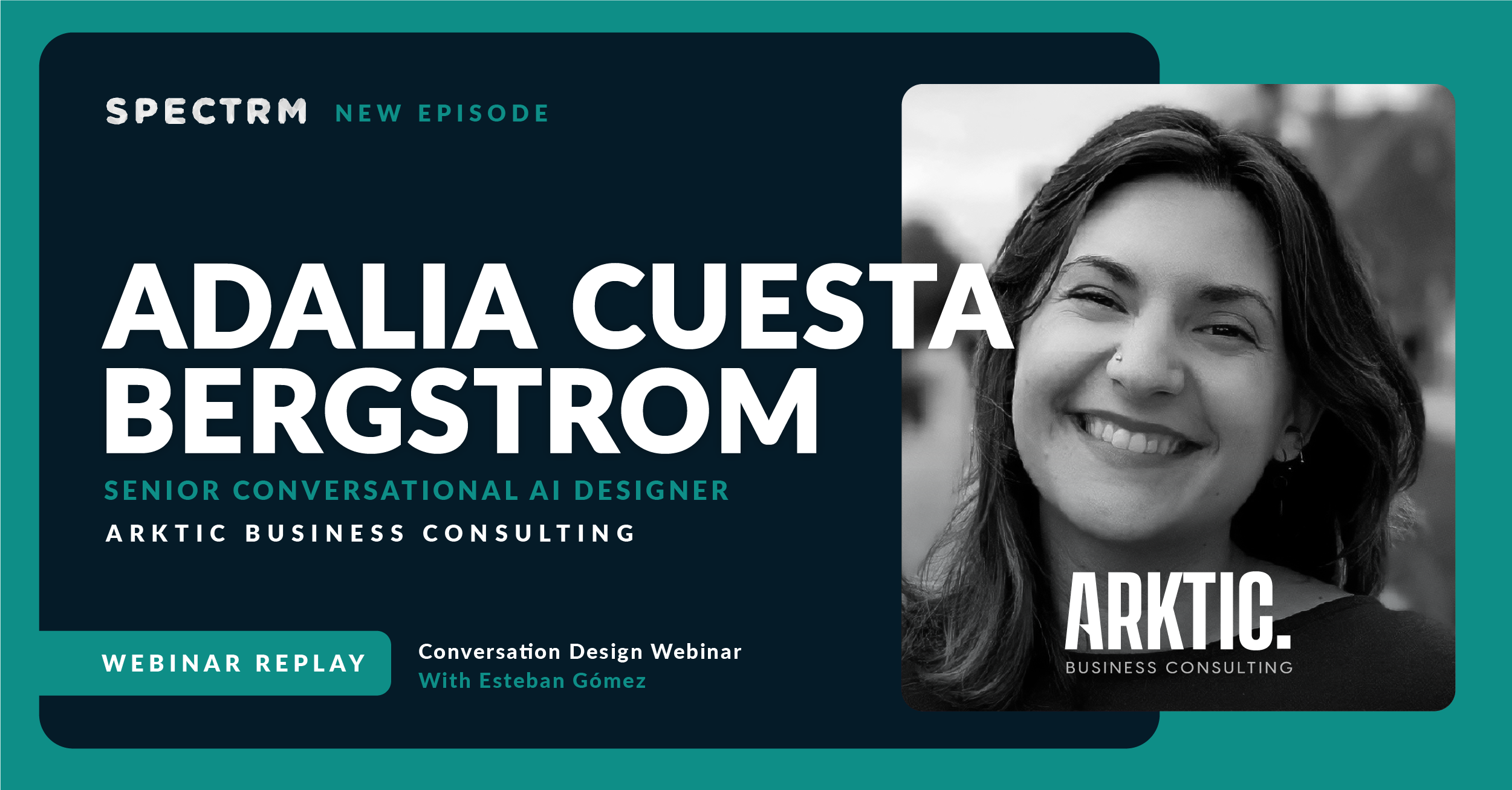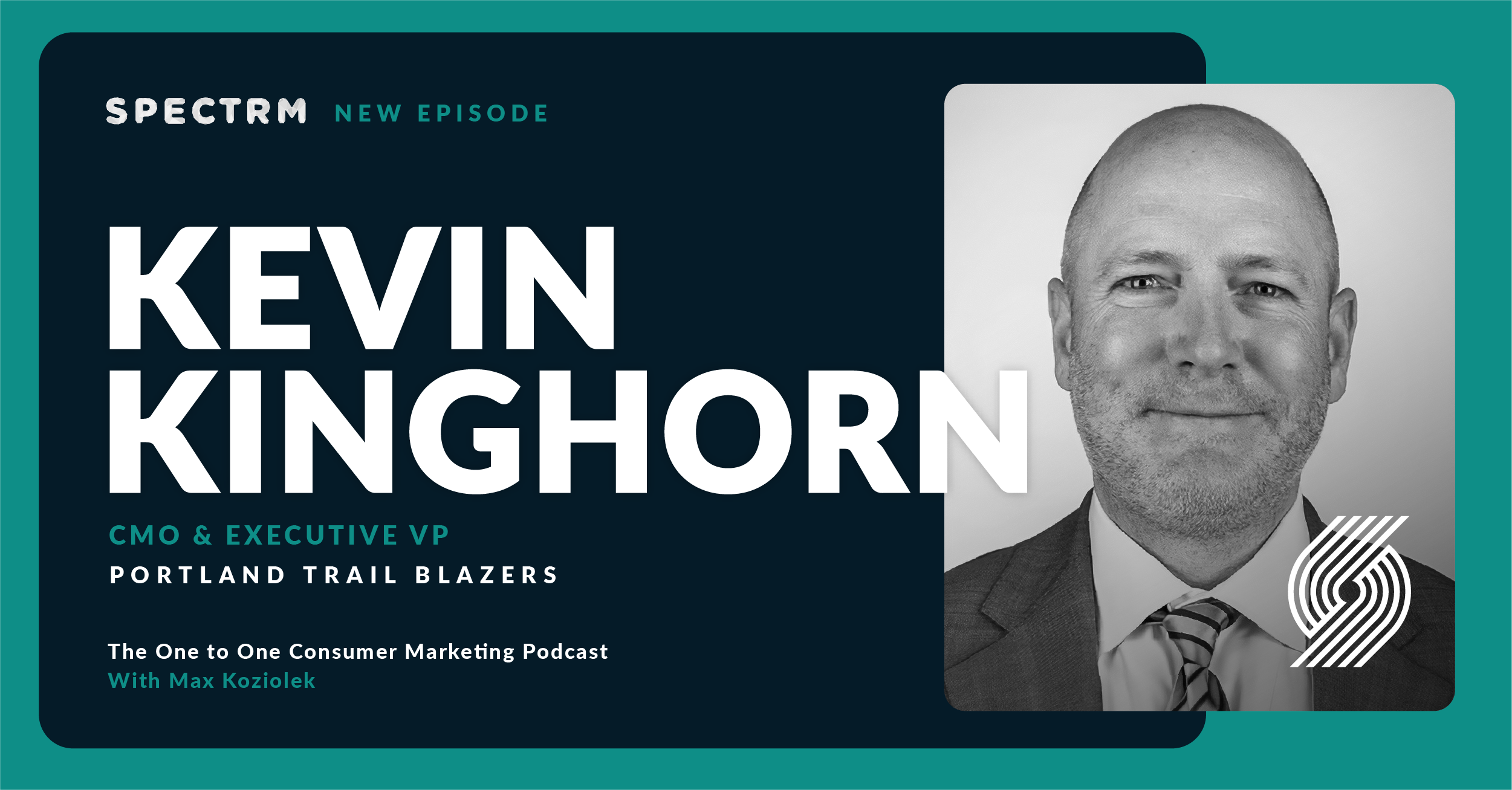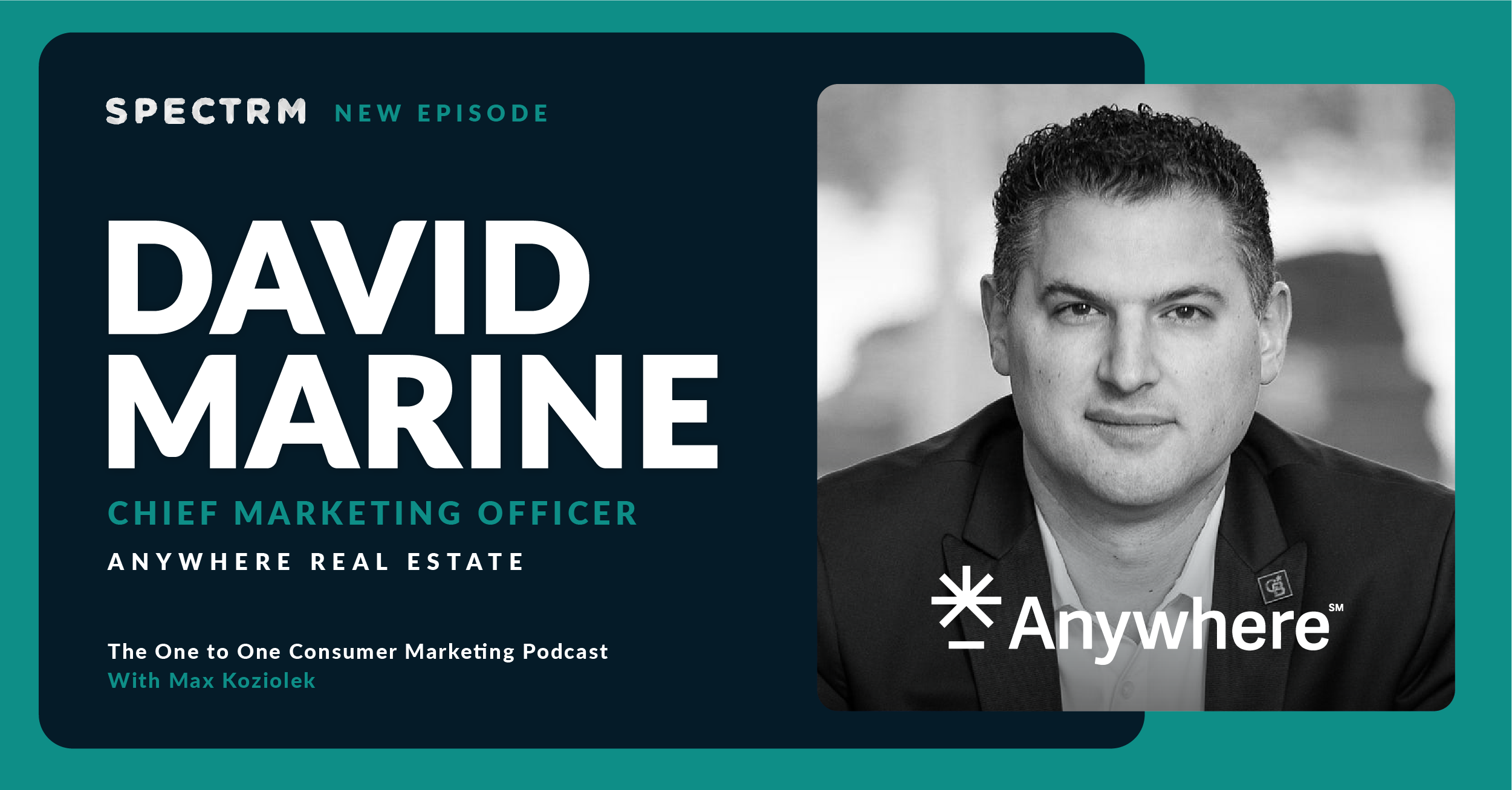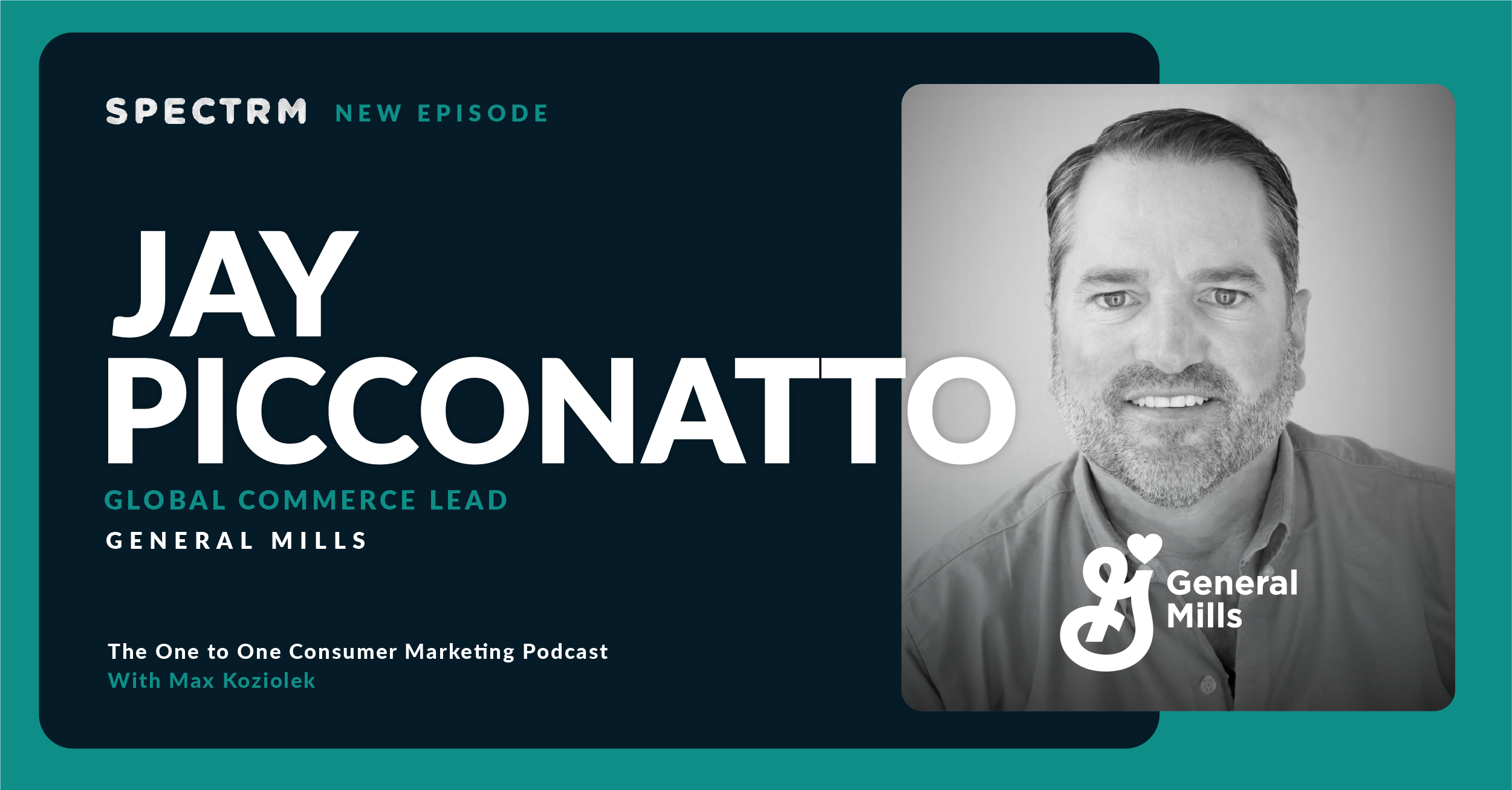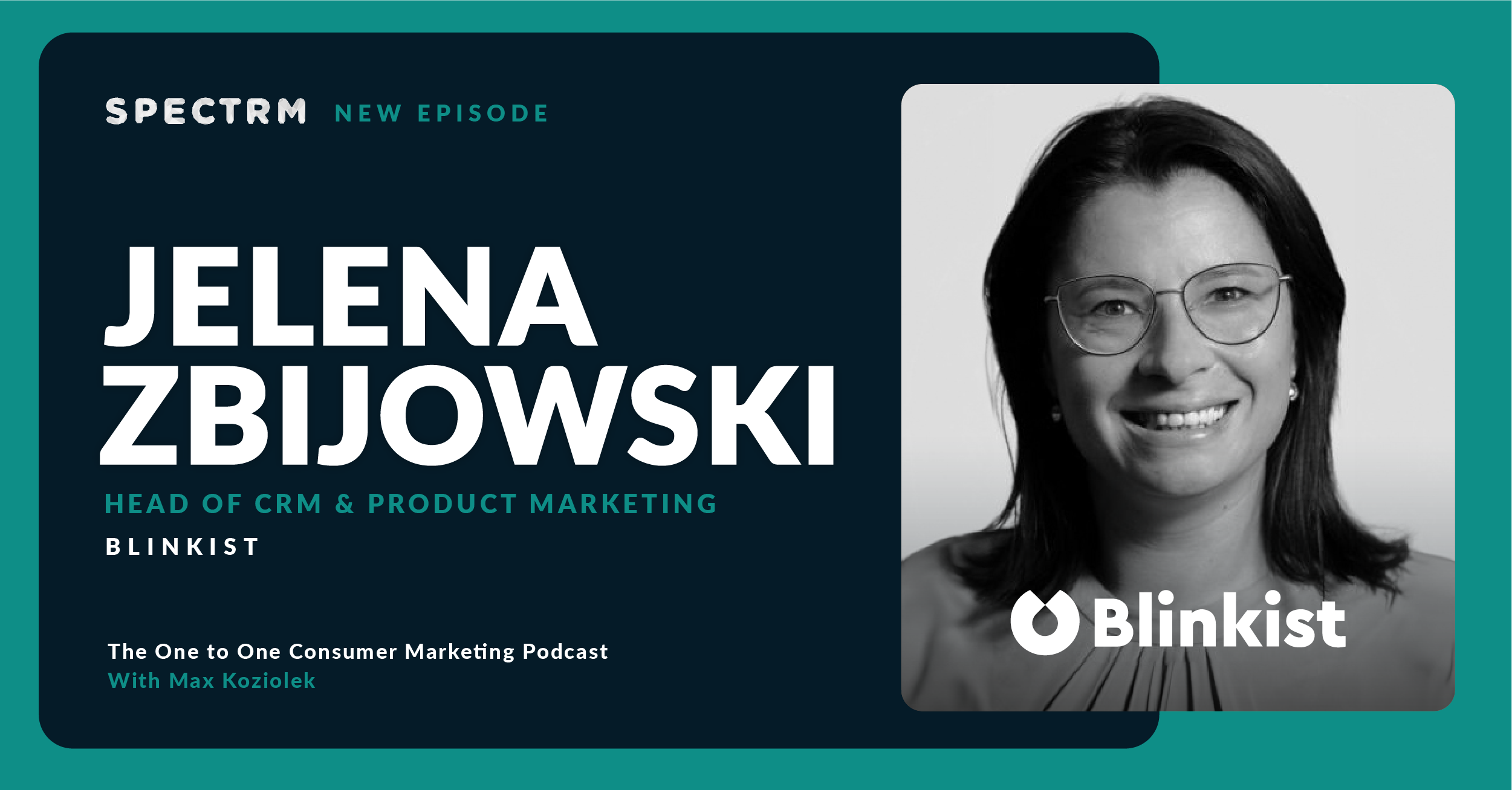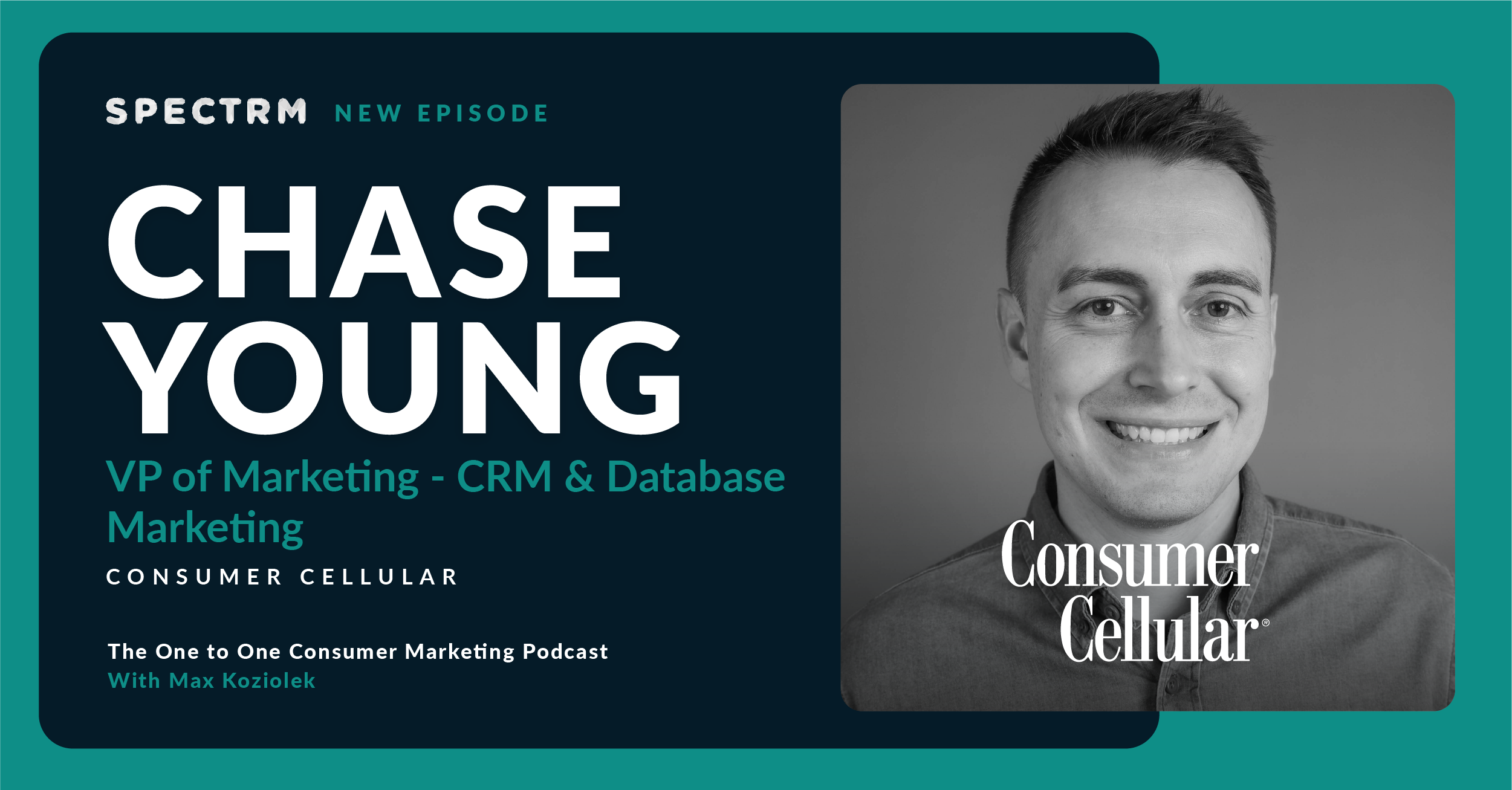Summary
Ben speaks with Peter Klein, Vice President of Customer Growth and Retention at Ideal Living. They talk about the evolution of consumer marketing from TV spots to influencers, as well as how to use data to not only segment customers but to answer their questions before they even ask them. They also discuss the rising use of automation to learn more about customers, and how deeper connections with brands will be the future of consumer marketing.
Topics discussed
- The evolution of consumer marketing, from the days of infomercials and TV spots, to using video sales letters to engage customers, to having influencers do the talking today.
- How Ideal Living retains customers and gets them to make second purchases by ensuring everything works smoothly during the customer journey the very first time.
- How Peter uses data to segment customers so that he can better engage with them according to their behavior, and how data enables Ideal Living to answer customer questions before they even ask them.
- How personalization and AI are shaping how marketers learn about their customers today — and how using AI to personalize too much may not be beneficial.
- How data helps Ideal Living evaluate which customers to save, and how marketers should constantly evaluate if the metrics they’re using fit their needs.
- Three pieces of advice for consumer marketers who want to make more of an impact, including the value of testing, how to increase positive engagements, and how to make the most of product launches.
- What the future of consumer marketing will look like, and why deeper connections with smaller brands may supplant large monolith grands.
How do we take the data that we know about a customer and provide the best solution for them, answer their questions before they ask, in a way that also lines up with our best case scenario. And they're really — as cheesy as it is — there are real win-win situations like that. So that's what I'm looking for: the next frontier of using data like that every step of the way.
Guest biography

- Executive with over 15 years of Direct Response experience, focusing on Marketing, Customer Experience, Operations, and Client Services.
Company overview
Ideal Living – Parent company to AirDoctor, AquaTru and AromaTru pride ourselves on being compassionate Innovators – Ideal Living is wellness-tech on a mission. We help by creating specific solutions, that are both truly effective and accessible for the discerning customer looking to optimize and protect their health and well being. By doing this we strive to become a beacon of integrity in the wellness industry.
Industry: wellness-tech | www.idealliving.com
Subscribe to the podcast newsletter
Transcript
00:24
Ben Gibert
Hey, everyone, and thanks for listening to and watching The One to One Consumer Marketing Podcast. Today I’m speaking with Peter Klein at Ideal Living. Peter, thanks for chatting with me today.
00:35
Peter Klein
Thank you so much, Ben. Really excited to be here.
00:37
Ben Gibert
Yeah, I’m looking forward to getting into some topics around customer retention, lifecycle, marketing, all the things that you’re doing at Ideal Living. Before we dive into that, can you give our audience a little background on yourself and how you ended up in your current role at Ideal Living?
00:51
Peter Klein
Absolutely. I’ve been in direct response marketing for almost 20 years now, which is crazy how that number keeps getting bigger, and it’s really been focused for the last dozen or so on the customer and retention and the customer experience. I was at Guthy-Renker, an infomercial giant with Proactive, Meaningful Beauty. Other brands like that on the current member marketing team, really focused on how to keep them in subscriptions and keep that experience. Good went from there to Golden Hippo, which is a big online direct response marketer. They have a ton of brands, and I realized there’s a theme, actually, with my career. Where they’ll see it is these large direct response kind of portfolio umbrella companies that have multiple brands in health and wellness. I work across the brands on all of them. At Golden Hippo, the largest brand there is Gundry MD, which is Dr. Stephen Gundry. A lot of video sales letters, and I was the chief customer officer there and also the CEO of their call center business and their fulfillment business for a while. It was really every aspect of the customer journey from as soon as we got them all the way through. For the last year and a half or so, I’ve been at Ideal Living, as you mentioned, in the vice president of customer growth and retention there. Ideal Living has multiple brands that are in those spaces and the home environment. Space is a big one for us with brands like AirDoctor, which is professional grade air purifiers, and AquaTru, which different water purifiers, with a lot of science and patents and everything behind it. It’s never a dull moment working on multiple brands at once and seeing how customers behave similarly and differently across the brand.
02:36
Peter Klein
So lots of fun. And I love direct response. The testing and learning and optimizing that never stops. It’s a real charge.
02:45
Ben Gibert
Yeah. Thank you for that insurer. I’m sure there’s a lot of things you can speak to when it comes to retention, given your experience, and I think most marketers, it’s already a big challenge doing retention and kind of customer growth at a single brand. Doing it across the portfolio is even more interesting, I think, or just presents very different challenges. I’m looking forward to getting into that. I mean, you mentioned running phone acquisition in some instances, like being in the industry for 20 years and the infomercial space too. I’m sure you’ve seen the space transform a lot. Can you talk through that evolution and how you see the current state of consumer marketing?
03:21
Peter Klein
Sure, yeah, it’s changed a lot. I remember so my earliest days I was working for a Dr consultancy and everything was TV, it was infomercials and spots and that’s how we got people. The attribution was simple, we had unique phone numbers, people called those numbers and we knew where the order came from. It was right at the cusp of things changing. I ran a campaign where we had a website, which was a new thing to do on a campaign. We put a toll free number on the website and saw that most of our orders came from that. Toll free number instead of whatever. We were running in the different spaces, which was eye opening, like, oh, so people are going to this website and then calling the numbers. Guthy-Renker, big Infomercial, Company, Proactive and those brands, that was still their main way of acquiring customers.
04:12
Peter Klein
When I went to Golden Hippo, where the video sales letter was a predominant channel of acquiring customers, it really was the evolutionary infomercial. It was the long form one that had different sections and each section has its own purpose. There has to be the introduction of the problem, the doctor or guru with their credentials. Here’s what people have tried in the past, here’s why it didn’t work, here’s why I’m personally driven to do this and TADA, here’s what I’m offering to solve it. The one big difference was with infomercials, you never knew where someone was starting in the infomercial because they were flipping the channel. There was a lot of repetition in the apps where you’d make sure you were hitting the same points throughout. There would be a two minute call to action through a few different times so that everyone was getting the features and benefits.
05:02
Peter Klein
With a video sales letter, where they’re starting and so you have a little more control and you can see where they’re dropping off and that’s where the testing and optimizing is amazing. With that, if you look and you see that people drop off at a certain point, you go switch that section out, test it again and see if you can flatten that curve out a little. So, yeah, it keeps changing and right now with the influencers and everything that we’re using at Ideal living, it’s similar. What it all comes down to when it’s a product that requires some kind of explanation is having a trusted voice telling you, this is why I like this and why you should look into it instead of just having something on the shelf. I think that’s kind of the true line from Infomercials and VSLs and Influencers, that’s what people want.
05:47
Peter Klein
When it’s not an impulse buy, when it’s a higher ticket item with some science behind it, when it’s health related, you want someone to really be able to explain, this is why it’s better than other things and why you should buy this.
05:58
Ben Gibert
Yeah, that’s such an interesting through line, through the evolution of the ways of doing marketing there that I personally haven’t thought of having not been exposed to so many infomercials back in the day, for sure, but not as much recently. I’d love to dig into that more. Like at Ideal Living, you mentioned the high average order value, like the more considered purchase and obviously the impact that has on acquisition, but also kind of customer growth and retention. Can you talk through more on that topic? Like, how are you doing it at today when consumers have so much information, so much power at their fingertips to make a more considered choice to kind of evaluate you against competitors? What is that doing to kind of your retention and acquisition?
06:42
Peter Klein
Right, that’s a good question. That’s one of the real benefits of the Influencer Channel, is that when someone hears from that trusted voice and there’s enough of an impulse to go to the site and use a coupon code or however we’re able to get them to go from hearing about it to taking action once they’re in the fold. That way, then we’ve done a lot of the work already. It comes to the retention side so take AirDoctor, for example. The units themselves are great and tested. There’s so many stats. If you go to Airdoctorpro.com, you’ll see just the number of clinicals and everything behind it. Every once in a while, every six months or so, or twelve depending on the unit, you need more filters. What we found on the email side, I oversee the email channel at Ideal Living is they’re already in on the science behind it, on why they need it in their lives.
07:35
Peter Klein
That makes the additional sales a lot easier because it’s just, hey, we’re having a sale on this thing that you need, and we’re going to make it easy to click here, which leads to higher click throughs and higher conversion, because it’s oh, yeah, I need that. I’m going to take a little detour here. Black Friday and Cyber Monday, we set some pretty audacious goals for the month of November and hit them. The main reason that I love that not just because of the revenue number, which is always nice to see. Every return customer, every return purchase is burned and it is incredibly validating to the entire process. When someone buys a second time, what it tells me as a marketer is we found them where they were, the message worked that they went, the website worked, the credit card processing, everything worked there. If they search because we know customers have multiple touch points before they buy, they didn’t see anything that turned them off in that path.
08:35
Peter Klein
We had inventory. The fulfillment team shipped it out on time, it arrived and the product works and meets the expectations that they had. If we missed any of those steps, they’re not buying from us a second time. Every time a customer buys something else from us, whether it’s another Purifier or from a cross sell another product from another brand of ours, it’s incredibly validating and tells me we did it right along the path of the first time. So that’s something that never gets old. The ROI is always great on those because there’s no additional acquisition cost when they’re existing customers. When you’re sending an email and they’re buying our time and the email provider, but that’s it. So those are always big wins.
09:20
Ben Gibert
Yeah, it sounds like when you create that coherent customer experience and everything works, it does feel great as a marketer to then see that sale and the revenue get added to the business. So I can imagine that’s very fulfilling. I mean, you mentioned the acquisition costs, like what you’re doing in terms of retention and how that’s growing customer lifetime value. Can you talk more about how retention and lifecycle marketing fits into your broader company strategy? And has that changed over time?
09:49
Peter Klein
Well, I’ll say it’s changed and it hasn’t in one regard. Some of the earlier products, that Ideal Living. Ideal Living has been around for a couple of decades and the two co founders, Katie Williams and Peter Spiegel, are legends in that industry and were around from the beginning of Infomercials, really, when that became its own industry. There was a time where supplements were some of the major products that were selling and really honed our ability to measure retention and keep people in memberships with products that were working and making their lives better. We got the bones of the metrics and that cadence down then. Now it’s different once you get into air and water purifiers and filters, but the mechanics are really the same. It’s, remember, these are all the benefits and why you need this, and we’re going to make it easy for you.
10:40
Peter Klein
It’s knowing what buttons to push and testing like crazy and making sure. So, for example, on AirDoctor, there are some knockoff filters that people can buy for less money. We have to get in front of that in our post purchase flow and everything to say, you just spent money on this amazing device. It’s like getting a Ferrari and putting olive oil in it. Make sure you’re putting the right thing in there, because we can only vouch for the efficacy if you’re using our filters in it. Making sure that we’re educating at the right point and ahead of time before they make that decision to look elsewhere because we want them to get the best out of it.
11:22
Ben Gibert
Yeah. Always a better idea to tackle it head on versus pretend like the alternative doesn’t exist. You mentioned metrics and kind of honing that ad process of refinement. Can you talk through about that? Like, what are you measuring from a retention standpoint? How are you honing the process, how you increasing the performance?
11:41
Peter Klein
Great. Yes. It’s something that we’re really on the cusp of even taking things to the next level with it, because it all comes down to, what do about your customers and how actionable is it? We have people on our list who are buyers and non buyers. Within that, we segment it into how engaged they are and they behave differently. So, for example, a non buyer, we may want to have a series for them that is a little more educational and getting them into the fold with a main unit, a purifier, while the existing buyers, it’s the filter, it’s the education. What we found and we have a great email partner called Alchemy Works who has taken our data and shown us for these different segments here’s, their tolerance of how many emails you can send them in a week before the unsub rate gets where we don’t want it.
12:31
Peter Klein
For our most engaged buyers, we have a lot of great content. They are not dropping off, even when we’re sending seven, eight, nine emails a week sometimes. We know, like, great, they want to hear from us. They are getting value from what we’re sending out. So that’s really helpful. To also see this area, maybe three or four a week is enough. We have to pick and choose what’s the most important message to tell this person on this part of their customer journey. So, when it comes to metrics, what I’ve seen in the past with other companies and other roles is sometimes being a little blinded by the day one ROI. That’s dangerous, because if something’s converting a little better, you shouldn’t just automatically call that a win and drop off the other one. What if the second one has more continuity subscribers and a longer lifetime value and you got them from a different channel?
13:23
Peter Klein
It’s really taking a step back and seeing the whole picture. If it’s a supplement membership, then I’m looking for average number of turns. Where are they dropping off typically? How do we get them a message? Right before the average cancellation date to remind them about the benefits or proper usage. And same with filters and warranties. It’s just looking at the data, seeing where do actions typically happen and what action do we want customers to take, how do we help get them along that path? And I have a story. It’ll take a little, but I think it’s worth it. I was at Guthey-Renker, Proactive would get ten to 12 million customer service phone calls a year. I mean, it was a main channel, which was great because I could test things and have significant data. We could test 10% of the list and one day have enough data to make a decision.
14:18
Peter Klein
What we found, one of my main charges was extending the lifetime value and the number of continuity shipments that customers got. We looked at the data and saw that if someone calls one to five or six days after their initial purchase, more likely than anything else, they’re calling, asking where their shipment is. If it’s day 28 or beyond that, it’s asking, what’s this charge on my card? Because that’s when the second installment or the second shipment was happening. Between seven and 27, though, was usually, more often than not, I want to cancel because I’m not seeing results. What we did was I worked with the It folks to have this data cache that we could recognize someone’s phone number when they called almost all the time, because phone numbers were still a big part of how people were ordering. When we recognized them, we had hundreds of data points on it, including their last shipment.
15:14
Peter Klein
Was it a starter kit and how many days it’s been. What we did was we implemented an automatic message that if they called and we recognized their number and it was between seven and 27 days from their initial order before anything else, before a menu where they could even push cancel to get to an agent would play an automated message that would say, thank you for joining the Proactive family. As a reminder, it can’t take six to eight weeks to see your full results. So follow the steps that Dr. Z, Rodan and Field played out for you. Remember to use all three products in order and stick with it. You’re doing a great job. Can’t wait to see your after photos. We’d pause, and a lot of the customers would hang up then because we answered their question before they even asked it, just by using data to have a marketing message, which truly, it was better for us, but it was better for them, too.
16:04
Peter Klein
They didn’t have to wait to talk to an agent any cold time. They didn’t have to have that conversation. It saved us that talk time, and chances are they were going to stick around a little longer and actually see results. Because the products worked for most of the customers. It’s that kind of thing that I would love to see us be able to do online and on the digital space now is how do we take the data that we know about a customer and provide the best solution for them answer their questions before they ask in a way that also lines up with our best case scenario. They’re really, as cheesy as it is, there are real win situations like that. That’s what I’m looking for, the next frontier of using data like that every step of the way.
16:47
Ben Gibert
Yeah, that’s a great example, I think, of identifying really, like, those trigger points in drop offs and what they’re actually looking for and proactively kind of dealing with it before it even gets to that. It’s a great example. I mean, you mentioned bringing that into how consumers interact today. Obviously, I imagine the phone is not as big a part of the channel mix anymore. As you deal with that change, what are some of the biggest challenges that you’re seeing in the space in terms of retention and loyalty?
17:16
Peter Klein
Yeah, good question. I just came from the Etail conference in Palm Springs and every panel roundtable keynote speaker, there were two main things, those personalization and AI, and those were hit hard every single time. One of the things that was really talked about was the importance of zero party data and what you can get from the customer. In a way that it’s not intrusive and they’re happy to share something to then get the deal. It can be as minor as do you rent or own your home? If we have a squeeze page and ask that question before they get so let’s say an influencer gives them a link, they click on it, they have a couple of questions survey before they get to the page. That would be really helpful for us on the AquaTru side, the water purification, because if they are renters, then they probably do not want the under the sink version of the water purifier where they have to install it versus a countertop one.
18:15
Peter Klein
That’s just a high level example. When you get that information, when you ask for it, and we survey customers all the time also, but when you ask for the information and get it, if you can immediately use that to make it a better path for them. I was thinking about this earlier, and I remember when Amazon started with the people who bought this product, also bought these things. It wasn’t at least to me, and feel free to if you had a different experience, but I wasn’t weirded out by that. Like, why are you looking at my behavior and suggesting things? It was helpful and they were right. Often I was looking for other things like that. There is a tolerance that we have of, yeah, you can use what about me if you’re going to present things that I’m interested in or help me solve the problem that I’ve already identified having.
19:03
Peter Klein
That’s where I kind of see, I want to do this much more than we currently are, but that’s where we’re really starting. How do we get data and immediately start using it so that it’s better for the customer and just a more seamless buying process?
19:17
Ben Gibert
Yeah, absolutely. I mean, that’s definitely what we see in the messaging space too. There’s a willingness to share zero party data that your customers are giving you explicitly in order to personalize the experience. I think your example of landing on a landing page and then the other one of Amazon is a good one because I would actually push back tiny bit on the Amazon one where I think the landing page example is one where you’re explicitly asking, and it’s clear to the person engaging, that if they give you that data, they’re going to have a personalized experience. So they’re more willing to do that. The Amazon one, I think, creeps people out more because they know that it’s probably data that’s being tracked in the background and they’re not actually explicitly giving it to you. That’s where I think a key difference lies, particularly with younger generations who are because I totally agree with you that zero party data, they’re so willing to give it in exchange for a better experience.
20:11
Ben Gibert
That really is, at the end of the day, what will drive more retention and more loyalty. I think great examples to put side by side. I mean, what channels we talked about the evolution from phone to web. What channels are you seeing work best? You mentioned you’re in charge of email. That your core channel now or what’s working for you?
20:33
Peter Klein
The influencers and different affiliates are still for the ideal living brands for those home environment products like Aridoctor and AquaTru. That’s a really big channel for us because as I mentioned, these are products that require some explanation and there are others that other products that seem similar. Having someone explain the differences and spend the time with it, that has been great for us and I think it will continue being great for the same reasons as the video sales letter will work, where it’s just walking them through then. Aside from that, we still do for some of our brands, some TV short form, we have some long form infomercials that have been running for 15 years and one still beat any new version that we test against it because the message is down and it works. That channel is not thriving quite the same way. At the same time, we’re looking at everything.
21:26
Peter Klein
We’re testing some direct mail, we’re testing different lead gen. This kind of ties into what we’re talking about too. I was saying our emails don’t have to be too specific right now because they’ve already understood the promise of the product and they’re in. I can’t use those same emails if we’re getting cold top of funnel people through a lead gen campaign. At that point, then I have to switch more to, all right, now, what are the main things that people want to hear and how do we address that? It’s completely different writing and it’s just that very basic marketing premise of knowing who you’re talking to and tailoring it to that audience.
22:04
Ben Gibert
Yeah, that touches I guess you also mentioned kind of personalization and AI being such a big part of the recent conference you went to. I think it’s something a lot of marketers are grappling with right now. You’ve touched on it in terms of how you build different segments in your list and kind of tailor your messaging to them. Are there other ways that you’re trying to connect kind of one to one with your current and potential customers?
22:29
Peter Klein
Yeah. Even though we’re all unique individuals, we’re not all really unique buyers and consumers, and we fit into buckets. I think we’re at an interesting inflection point with some of this technology where we shouldn’t be trying to have an absolutely unique experience for every single customer. I can see people really getting lost in the detail with that or trying to use and that’s where Chat GPT and AI, I think it depends on how people are using it. If people are trying to really have it be unique for everyone, then that’s not going to be the dial moving thing versus the 80 20 rule or you have five different twenty s to make up your customer base. You look at that and say, all right, how do we help with what we know about them? I think that’s the way to really use this technology is to find I’ll call medium picture adjustments instead of getting too granular.
23:25
Peter Klein
As far as AI and the chat goes, we just had something come up recently where we wanted a blog post about something that ends like, if we can get this out today, that would be great. Someone went to Chat GPT, typed in really just a couple of things and got a blog post that then our head of Copywriting spent a few minutes with, made it better because it wasn’t quite right, but it was still very impressive as a starting document. Were able to shape that, change it and make it in our voice and get it out really quickly. That’s where, if used properly, I see AI really helping propel the speed of things getting done. Because I know for me, I’m a much better editor if there are bullets or a first version down versus a blank page in front of me. I think that’s really going to help kick start things.
24:15
Peter Klein
Unless people are just using it for fun. Like, my son asked ChatGPT to write a sea shanty about the 2000 Lakes, which is something, and it did. It was very impressive. I don’t want to get too lost in the fine side of it when we can actually have some actionable insights from it.
24:35
Ben Gibert
Yeah, I think that shift from creation more towards editing and kind of curation will probably accelerate very quickly with those types of technologies. Coming back to what you said about the 80/20 rule and really identifying the core buckets of customers and how you can nurture them to a purchase, I think is a very important point because it’s so easy, especially for CRM marketers and retention marketers, to be swimming in a sea of data and potential channels of engagement. Simplifying it down to that level is powerful. I think what we’ve seen with our customers, too, is that it’s not necessarily the totally unique one to one level of personalization in terms of the actual experience that matters, but connecting on the channels where consumers are and where they want to engage in an almost one to one way, that’s why messaging shines. It’s not that everyone’s conversation is unique, but it feels like a one to one connection between the brand and the customer, which ultimately can be very powerful.
25:36
Ben Gibert
You mentioned ChatGPT. What are for you, kind of the more exciting consumer marketing trends at the moment.
25:43
Peter Klein
I would love the ability to visualize our data and find those exciting buckets. That the thing that I get most excited about, is the example I used with Proactive earlier. How do we use data to identify not just the customer segments, but an actual behavior that we either want to encourage or discourage and have? Another example from that, because Guthey-Renker just had so much data with the number of customers and everything. One thing that we found was customers who had canceled or called to cancel a membership and were saved. If they called another time after that to cancel and were saved a second time, the lifetime value after that second save was negative. They would get shipped something and more often than not return it or cancel it was not worth saving them a second time. What we did was we instituted a previously saved flag in that data cache so that if someone called and we saw that they had been saved, if they pressed cancel instead of the normal path would be you wait on hold, you’d talk to an agent, talk to them, and we’d save 25, 30% of people.
26:55
Peter Klein
If they had that previously saved flag, it was a message that said, okay, your account has been canceled. Thank you. And that was it. It saved us talk time. It saved dollars, and it was a business decision based on the data and the behavior of the customers. Again, it was better for the customer. They. Didn’t have to have that conversation and try to be saved again. That’s what I see happening is that in the online world is finding what we owe either given to us directly from the customer or just their behavior in a CRM, being able to map out their journey and institute those I’ll call them pre knowledge tests of we think this is what they’re going to do. Let’s see if we’re actually answering their question or not. And that’s the fun part. I hope that’s what the future holds is that these technologies enable us to just implement more and more of those tests.
27:45
Peter Klein
Because when those work and you really see that the satisfaction is high and we’re not high fiveing around the office, but it’s a symbolic high five. I can sense it.
27:54
Ben Gibert
Yeah, I like that example too, because it’s about zooming out a bit too right from the data and then not getting stuck in like, oh, the renewal is what matters. We got a renewal, but okay, actually the lifetime value becomes negative in this event, so let’s change our approach and bigger picture that’s better for the company. It’s definitely the kind of thing that we hope predictive modeling and things like that can do in the future. So there’s a lot of promise there.
28:17
Peter Klein
There is. One quick thing on that is the analytics team told me something once at Guthey-Renker that really surprised me, which was we don’t want the save rate to get higher than a certain number. That just blew my mind because I thought, well, why don’t we want to save everyone who says that they want to cancel? What they saw was after a certain point, we’re saving some people who we shouldn’t save, who are not going to stay on it, and who are going to end up costing us more money. Let’s find ways to presave people with information before they even call to cancel. That changes the metrics that you’re looking at because the save rate going down may actually be a good sign. That means that you educated them on their ability to change their frequency of their shipments or something like that before they called to cancel and learned it at that point.
29:06
Peter Klein
Looking at maybe we need to see overall cancel rate in a given day or week instead of looking at the save rate because all of it goes into the same thing. That part is cool, too, is like, hey, this metric no longer fits our needs. What are we really trying to get at here? What should we be measuring to tell us the story?
29:27
Ben Gibert
Yeah, great example of those differences. You’ve worked across a number of different brands. You have that experience that spends 20 years, you said at the beginning of the interview, what are kind of the top three pieces of advice you would give other marketers or things you wish you knew at the start of your career that now.
29:44
Peter Klein
Oh boy. Well first, and I think this hits both of those is test, test every single thing you can and when something wins don’t sit on your laurels and celebrate. You get your next test and you can always optimize. The reason that touches on things I wish I knew because there are so many times that I thought something was either a surefire hit that did not win or I thought why would anyone in the world like this ad? And it blew away the control. So yeah, no one knows anything. That’s the first thing and that’s the point of testing. There’s that second it’s a really know your pain points and what you’re willing to do about it. For the golden hippo brands Mark Clemens, the CEO was very he wanted to make sure that whenever someone looked somewhere else on the internet that they wouldn’t see something negative about the brand that would change their mind.
30:40
Peter Klein
What that meant was spending extra attention on having our Better Business Bureau grades all be a pluses and a’s or staffing call centers so that calls were answered quickly and there weren’t going to be any negative comments about I can never get a hold of someone and making sure that’s your pain point. I don’t want negative reviews. Spend the time and money to ask your customers for reviews and create a flow where you’re getting them. That’s the second thing is really if you identify a pain point what are you willing to do about it because you can fix it. The third thing is say really making the most of new product launches. It’s something that I’ve seen people do poorly and incredibly well and when you have something new you can either use the Jeff Walker product launch blueprint where it’s just you say to your customers you ask and we’re working on it, can’t wait to tell you more.
31:37
Peter Klein
The next email is I can’t say much yet but really excited about the progress we’re making. The next is maybe here are some ingredients we’re going to be using and some of the clinicals behind them. This is great. Stay tuned until you get to the point a couple of weeks later where you’re saying now you have the right to now you can sign up for the presale they are in and these are your best customers, your evangelists. That versus just been places where they just put a new product up on the website that was their version of and maybe there was a banner but that was how they launched a new product. Those are the two extremes but really pay attention to that because your best customers and existing customers they’re going to be very honest with you with their wallets and with their keyboards on how they feel about new products and then you can use that when starting acquisition campaigns.
32:30
Peter Klein
These are the roadblocks that we face now. Let’s get in front of it with how we’re acquiring customers and address it head on. I think those are three at least.
32:38
Ben Gibert
Okay, yeah, those are good pieces of device. Always test the power of good product launches. I think particularly in the context of Priming and the doubling down on whether you identified a pain point, make sure you take action to fix it. I think all things that marketers would benefit from implementing in their own careers as we wrap up. No one likes to make predictions, but five years from now, what is the future of consumer marketing look like for you?
33:09
Peter Klein
I sure wish I definitively knew that answer. My wife is a trained psychologist and she would say that the best predictor of future behavior is past behavior. I think if I glance into the crystal ball, I would say five years from now there will be some emerging technologies that people are wondering, are these really going to revolutionize the way we do things? With complaints about Attribution and some iOS changes, I think that is going to be or whatever the equivalent of it is then. I think the personalization aspect, I expect that to really take a giant leap in terms of maybe we don’t have these monolith brands anymore that speak to all people when we have the chance to say what do you want and how can we help serve you? If that means that we have some real loyalists with certain brands but I don’t think there are going to be as many one size fits all and we’re already seeing that there are so many similar companies in the same space.
34:08
Peter Klein
I think that’s where we’re going is just some hyper targeted but very deep connections with brands that solve the problems. Customers are smart and if they say this is what we want, then it’s up to the marketers to help provide that solution in a way that actually addresses it. I’m hoping that trend will also get some of the bad actors and crappy products out of the marketplace because people like I was talking about those earned second purchases. I would love to see the people who just throw something up, the ads I see with claims that no one is able to make and before and after putting a picture of Oprah on there when she absolutely did not endorse that product. I want to see all of those go away so that the companies like the ones that I have been privileged to work for, who really are trying to improve people’s lives with their products, can get a stronger foothold.
35:00
Ben Gibert
Yeah, I mean, I think that idea of hyper targeted messaging and deep connection to consumers is one that’s a great note to end on. I think that would be a very positive future for consumer marketing so we.
35:15
Ben Gibert
That’s what we’re going to have time for today. Before we wrap up, if people want to follow you and learn more about what you’re doing and your journey, where should they go?
35:23
Peter Klein
Best place. I’m one of maybe 500 Peter Klein’s on LinkedIn. I’m the one who works at Ideal Living. I don’t post too much there, but come find me. And I mean this 100% sincerely. I love having conversations like these and being an extra set of eyes on anything that people are working on. If someone wants to reach out, say, you heard me on this. I would love to get that feedback too. Anytime someone just wants to chat about marketing, I love this stuff and could do it all day. LinkedIn is probably the best place for that.
35:54
Ben Gibert
Yeah. Thank you so much for joining today. It’s been a lot of fun. I enjoyed this conversation, too. I love having conversations like this with other marketers as well. You heard Peter Klein one of 500, but if you combine that with Ideal Living, I’m sure you’ll find him. Send him a DM about your thoughts on the podcast. If you want to learn more about what we’re doing or send me feedback on the podcast, come to me on LinkedIn, send me a DM. I’d love to hear from you. Or check out Spectrm on LinkedIn or Spectrm.io. And thanks for your time today. Peter, it was great to have you on the podcast.
36:26
Peter Klein
Yeah, thank you so much, Ben. This was a lot of fun.
